Text
When words aren’t enough
We headed back to Calais last weekend. The camp has gone through radical changes and the southern camp had been destroyed since our last visit, marked out here in this photo. The sandy land around it was bulldozed earlier in the year.

The southern camp contained much of the grassroots aid infrastructure: distribution points, Ashram kitchen (which we support), the family zone with its caravans, the women and children’s centre, legal centre, youth centre, theatre dome, library, school and places of worship.
The evictions were brutal. Watching it from the sidelines, hearing from refugees in the camp and reading the pleas for help from the volunteers on the ground was painful. It’s hard to reconcile that there are hundreds of unaccompanied children, the youngest just 10 years old, watching the camp burn, choking on tear gas and being hit by rubber bullets. Some suffered worse; there are reports of severe sexual assault.
Only the school, library, youth centre and Eritrean church survived. Everything else has gone from the southern camp.
Watch the video
I put this film together to show before and after the evictions and the impact on refugees.
youtube
For the thousands made homeless by the eviction, the options were limited:
1. The government tents: storm damaged, flooded and providing little protection at all. They are useless.
2. Biometric container camp: Housing 1500 people, many didn’t want to hand over their fingerprints because they want to go to the UK. Kids and families can’t stay here and there weren’t enough places for all those displaced. It’s also full.
3. Buses to unknown centres: The officials put on buses to take people to immigration centres all over France. There weren’t enough places and some were only open until end of March.
4. Asylum in France: The legal process is very difficult. Soe in the camp have applied and have been waiting many months for paperwork. In the meantime they face destitution and homelessness so rely on the camp to survive.
What we saw on our return
As we headed in under the bridge, the sight we saw was shocking. It looked like a Hollywood disaster film set.

In the distance the blue Eritrean church was surrounded by a barren, bulldozed wasteland. To our right was a smoking, tangled mess of burned metal and wood. This was the remains of the Afghan Square and its shops and community now lay in ruins at our feet. As we walked the length of what was the high street, we saw shoes, photos and utensils poking out of bulldozed mounds of earth.
We made our way to the northern camp to see our friends in Sudan, but we could sense the air of desperation. I’ve never seen so many blank faces and people obviously suffering trauma. Children came up to us asking for things and were in obvious need.
The northern camp is overpacked and cramped with relocated refugees from the south. Nationalities are now right on top of one another and shelters are touching in places, posing a fire risk.
We delivered our direct donations and ate delicious meals with our friends, young men in their early twenties with so much energy, will to survive and skills to offer. I can’t even describe just how good that food tasted.
The refugees know this is the end of the camp (the official line is two more months) but say it will not solve the problem. People are fleeing extreme circumstances and have nothing to lose. The French have repeatedly removed camps in Calais since 2004. They always return.
I asked our friends whether volunteers have helped or hindered, something which weighs heavily on my conscience. It’s a fine line between having enough to survive and making this lifestyle permanent. No one wants to live in the camp for long.
One explained: “Volunteers brought the media, the media brought attention from government, this meant fences and fences made getting to the UK very hard. Before, it was easy.”
Now we’re in a vicious circle of doom. The fences mean the refugees can’t move on to the UK so they have to stay in the camp for longer and need the aid provided by small charities and ordinary people. Before the fences, people would be gone within four months on average and now it is not unusual to meet people who have been in the camp for over a year.
Our Sundanese friends are stuck in Calais, desperate to join their family and friends already in the UK. Their lives remain frozen in time and they use their phones to remain connected with the outside world. There’s nothing they don’t know about global politics and we laugh about the ridiculousness of Donald Trump.
But when it comes to the volunteer aid movement, it’s clear to me that the need is much more than sleeping bags and food donations. Taking the time to get to know people and understand their circumstances, culture and difficulties is as important.
Before we arrived last weekend, I got a message that said: “What makes me strong is the people who are supplying and supporting me and the most important thing is staying beside us. So I think my god because he gave us your group.”
And beside them we stay regardless of what happens in Calais. I feel it is me that should be thankful to them, for involving us in their community so warmly and showing us how they look after each other, sharing everything they have. To me they are friends, not refugees.
If you don’t understand why people are fleeing Sudan, watch this amazing poetry slam and you’ll get an idea.
youtube
0 notes
Text
A valentine for those in Calais no government wants to love
We recently headed to Calais camp and had planned to volunteer in the kitchens chopping veg, but we learned about the struggles of the Sudanese people instead. That afternoon was precious as we shared experiences of our cultures and huddled in their tent while the wind howled and the hail stabbed the sodden sand dunes.
“We are too black for our country. They want to get rid of us in Dafur, in the villages. They want new people, Arab people,” said Ahmed, our host and teacher of all things Sudan for the day. And this is how our education began as they shared what they had so generously, explained their culture and spoke of their dreams.
The camp was ringed by the French CRS force, with its white vans and water canons stationed around the perimeter. The presence of personnel sheathed in intimating riot gear has really ramped up since the 100m exclusion zone was bulldozed recently. They examine volunteers’ cars closely and issue fines for any minor defect.
After dropping a car full of fresh fruit and bread at the warehouse, we got through the camp CRS cordon and parked up. We walked through the back of the camp and it was obvious at once that the atmosphere had changed. It was quiet and people looked forlorn as they queued at a distribution centre. The easy smiles we saw in November had disappeared in some parts of camp. With the forced clearance of part of the camp recently, it was no surprise. Two young Afghan teenagers followed us around but their faces were expressionless.

We headed to Ashram kitchen, handed a cash donation over but it was clear they had enough volunteers for the day. So we called the number of a refugee from Sudan to drop off a direct donation.
youtube
The Sudanese community
Abdalla and Ahmed from Sudan met us at the theatre dome. I walked with Abdalla, who was kind, polite and cheerful, and we dodged the worst of the mud and talked about life in the camp. He said it was becoming very difficult and walked us to the newly bulldozed zone. It was shocking. Just a couple of months ago this area has been full of life with churches, mosques and communities. Now it was a vast desert with a huge fence on one side and a man-made sand dune on the other.

“Very hard to get to the UK now. Very hard to get out of the camp in the daytime. We are prisoners,” we were told.
As we trudged gingerly to the Sudan area we walked past the Afghan shops selling food. I was told that the shops charge a fair price for the goods but access to hot water is very difficult. I asked if they use the shower at the Jules Ferry centre and was told, “Queue outside in the cold for two hours for a couple of minutes in a shower? No. It’s too difficult.”
And cold it was too. As we walked, the sky darkened and unleashed a freezing hail storm and high winds. We ran for cover, sheltering under the roof of the Three Idiots café. In those few minutes we were sodden and my jeans stuck to my frozen legs. Our hosts had waterproof trousers on. A wise move.
youtube
The storm continued so we ran on some more to a nearby marquee. This was a Sudanese shelter and home to 40 refugees. Inside were rows of beds, bikes near the entrance and a gas ring in the middle, which everyone was standing around.
The hail eased and we carried on walking. We walked past the French government’s new container camp. Bleak and stark containers were stacked on top of each other in rows. Each container had bunkbeds to house 12 people. There is nothing personal or cultural in this zone. It is expressionless and empty without community. It looks like a concentration camp, ringed by a ditch and patrolled by guard dogs. Freedom of movement is not guaranteed and entry is by fingerprints. We asked our guides if they would move in there. “We don’t trust them, so we don’t want to go in,” they told us. These may have heat but giving up freedom of movement, dreams and community is a tough ask.
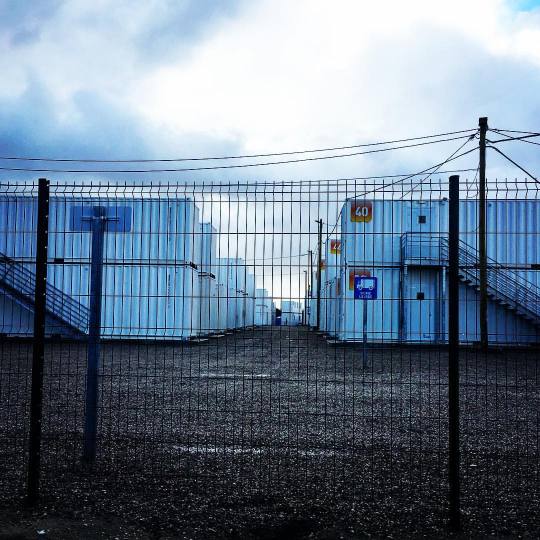
The pallet house
Our hosts took us to meet their friends in an amazing two-story house made entirely of pallets. The outside was painted with a beautiful leopard and inside was super tidy with a kitchen area, seats and table and a bedroom.
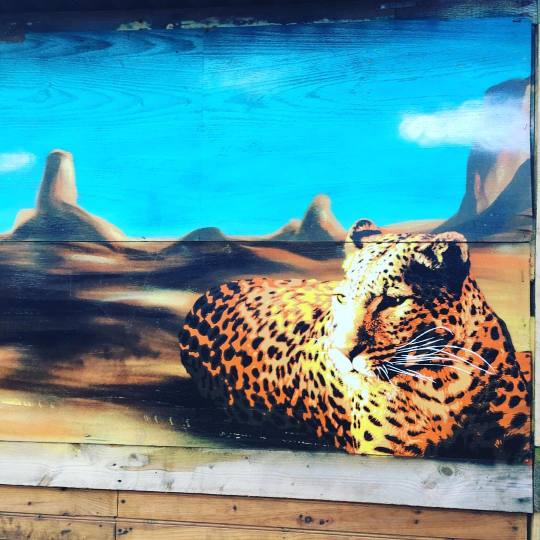
On the stove a pan was boiling away and we were offered cups of hot, sugary coffee. In the centre of the hut was a dynamo bike. We learned that if you pedalled at 12mph you could charge phones and on top of the handlebars were a dozen USB charging cables. My friend Lee got on the bike and pedalled to charge some phones in return for the drinks.
youtube
We chatted to Amin, a young bridge builder from Sudan who had been in the camp for more than a year. He’d tried to get into the UK every night for six months. He’d been “found” several times and his face contorted with fear when we talked about guard dogs. None of the people we chatted to in the hut were hopeful about getting to the UK and didn’t feel safe in France because of treatment by the CRS.
King of the jungle
Abdalla and Ahmed walked us back to their tent so we could hand over a donation to a young man called Jamal. We entered the community tent, which had a kitchen area, a table and chairs. Some men were playing cards and room was found for us to join in. Jamal and I paired up and we started to play a baffling card game, which involved complicated numbers. I was rubbish but Jamal got us to win and I was crowned King of the jungle. The hot tea and milk flowed, while the hail and wind returned outside. The hot drinks were so important to help keep the body temperature up.
youtube
Soon our conversation turned to Sudan. Our hosts explained that the country has been in turmoil for years and it worsened after Sudan joined the Arab League, a sort of EU for Arab nations. In Dafur, our hosts said there has been genocide and raping of women. The fighting and poverty has made life extremely difficult. They also said the colour of their skin was a problem, that they were too black and the regime favoured Arabs.
Ahmed inferred that they didn’t fit in anywhere in the world and even David Cameron doesn’t like them them. He knew that they had been called “a bunch of migrants” and asked why he would say such a thing? I said that David Cameron says a lot of things that disappoint us.
Eating Sudanese-style
Our hosts wanted us to eat with them and we knew that this was a very important thing for them to do. We chose curry and all the men took turns to take part in the meal preparation.

I helped Jamal chop the onions, another man smashed up garlic in a bottle (an ingenious method), while tins of sardines and spices were added to the pan. As the meal simmered away, Ahmed showed us pictures of Sudan, from the beautiful plains, indigenous animals, amber-coloured mountains, opulent wedding ceremonies and delicious food.
A new blanket was opened and spread over the table and we sat down to eat. We scooped the hot food straight from the pan using chunks of bread. It tasted amazing.

As we made our move to get the ferry home, Ahmed insisted on walking all the way back to the car with us. Hosting is serious business in Sudan and you are walked into the house and out again. Ahmed said: “My house is now your house.” I found that very moving as we said our goodbyes and watched him trudge back through the deep puddles and mud to his tent.
All lives matter
So these are the “bunch of migrants” that David Cameron tells us about, people so generous with what they have and so willing to host strangers. Why can’t we do the same?

Now the news has broken that half the jungle is to be bulldozed again, including the churches, kitchens, treatment centre, school and theatre, as well as the zone housing the families. I can only think about the men I met and the human-to-human interaction we shared. All lives matter and I am glad that the grassroots movement self-organised to provide humanity where our governments have failed. Help me raise money for Calais via PayPal: [email protected]
Watch a video of our trip ...
youtube
0 notes
Link
The information on the grassroots Facebook pages is extensive but the posts move so fast that this valuable resource can become confusing. I tracked back through the posts to put together a summary of the very latest information as provided by the long term volunteers at Calais.
0 notes
Text
Collecting food for Calais and the distribution set up
During our recent visit to Calais we focused on food, which was a priority for our group after the October convoy.
The photograph of the drowned Syrian toddler, Aylan Kurdi, splashed around the world meant the Facebook pages of the grassroots movement was inundated with offers of help.
A few months on, the Paris attacks and deteriorating weather has meant that some people are staying away from visiting Calais and the residents are feeling the impact. Donations have fallen. For now, warehouse supplies are holding and volunteers are managing to carry out several food drops a day in the camp but the atmosphere is more tense than ever as people struggle in the cold.
Getting food is one problem, another is being able to cook it. Camp fires need firewood and are hard to sustain in biting winds and collapsed shelters. Cooking food that needs a roiling boil, such as rice, is a challenge.
Jules Ferry centre
The Government-funded Jules Ferry Centre offers hot meals for 1,500 people each day, but the camp has expanded hugely this year and this hot food offer is inadequate to feed the 6,000+ people in the camp.
Shopping

Some residents walk to visit local cafes or supermarkets for provisions but now the border fences are so good, people are staying longer in the camp and money to buy supplies is dwindling.
There’s a large number of shops in the camp selling goods and cooked food such as fried chicken, fries, fresh bread and national dishes. The restaurants are vibrant and busy, although it was difficult to understand how they are stocked and how people pay for it. Carrying cash and stocking goods is a challenge in a densely populated place where most have very little. Tensions can rise easily.
Electronic transfer of money is also challenging because much of the camp suffers from very little phone signal. To get a good signal, you need to go out of the camp which can be tricky if the police are present.
Food parcels

Volunteers provide several direct distributions a day, handing out food packages made up of goods donated to the warehouse. The most helpful thing the grassroots movement can do is pre-sort food into equal food packages placed in individual carrier bags or bin bags before bringing them to the warehouse.
Collecting and packing in this way means these parcels can go straight out to the camp without any warehouse effort or delay. Giving out the same food parcels maximises distribution with dignity, as the packages are the same, preventing residents from feeling they are missing out on what someone else has in their parcel.
These are the sorts of foods which are welcome - note it doesn’t include baked beans, pasta or other foods which are likely to be unfamiliar to them:

Sweets are also absent from this picture. The children clamour for fresh fruit and sweets are not helpful, particularly because there is a lack of access to dentists and dental hygiene is difficult.
Communal kitchens

There are also volunteer-led communal kitchens which use donated food to cook for the masses. When we went over we wanted to support One Spirit Ashram Kitchen - a communal kitchen where volunteers and refugees prepare food for other refugees.
We used our raised funds to buy 20 loaves of bread and dozens of eggs which were used for breakfast. JoJo’s restaurant used their food supplier to help us buy a 20kg sack of onions, three crates of fresh tomatoes, two crates of peppers, a crate of fresh ginger, a bag of chillies, catering packs of tomato paste, and loads of other goods. We also went to a Cash n Carry to get nuts, fresh oranges and apples, lemon juice, lentils, large packs of spices and much more. I’d also collected from people in Whitstable via Windy Corner loads of tins of tomatoes, chickpeas, kidney beans, oil, salt, sugar among many other items.

We had fewer cars on this second convoy, which was just after the Paris attacks. We were worried about fitting everything in and the weight of the vehicles. This limited our spending capability this time around.
Flexibility is vital
When we arrived at the warehouse, Ashram Kitchen told us that they needed to secure all this food and they were expecting delivery of a storage container in two days time. Until then we needed storage to take all this food into the camp and we were worried about the fresh food spoiling in the meantime.
The Ashram kitchen is a basic marquee with a lockup trailer attached where the gas burners and food are kept. The big container will help them store more stuff and keep it secure in the future.
We offered to spend our funds to hire a van, but everything is shut on Sunday in France. After some haggling, Matt from Ashram Kitchen found a warehouse van he could borrow for two days. We loaded our food in the van and agreed to meet him and Lizzie in the camp at 1pm to prepare for evening service.
The one major thing I took away from this experience is you need to be flexible. You may intend to give to specific project but your best efforts can be thwarted by things beyond your control, such as the items are not needed on that day, you can’t locate your contact on the ground for delivery, police refusing access to camp, lack of passes to get into the camp or lack of storage for your goods on the camp. This is where the warehouse offers fallback storage and advice if you can be flexible and allow your goods to be redistributed so they don’t go to waste.
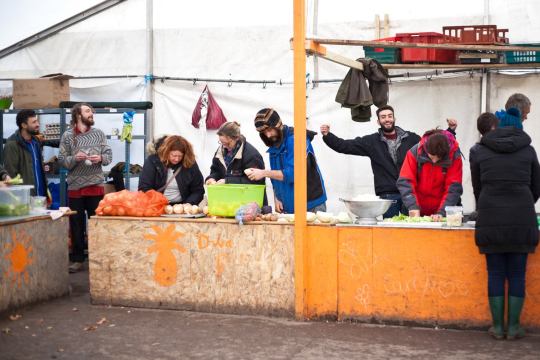
The endless chopping and peeling
We arrived at the kitchen and got to work. The equipment was basic and there weren’t enough sharp knives to go around and at one point we had just cutlery to cut up onions. All the onions, tomatoes and peppers were chopped - it look a production line of six people 90 mins to prep all the food, including opening zillions of cans of beans, chickpeas and tomatoes, many of which didn’t have ring pulls. This is why ring pull cans are essential. It’s amazing how much food it takes to fill three giant catering food pans.
I worked opposite a refugee with piercing blue eyes. He didn’t speak much English, but we laughed and smiled at each other as we sprayed each other with onion juice. Another refugee kept sweeping up the peelings, joking with mimes that we were for it if we kept littering. He is the man with the big smile in the photo.

Another did a lot of the heavy lifting between the van and the kitchen. As he moved h,is cough echoed around the room and it was a terrifying hack. I assume he suffers from Jungle Lung, a viral infection specific to Calais camp because of the unique mix of pollutants in the air and soil. Access to medicine is minimal in the camp and antibiotics are scarce. How will this man fair during the winter?

As we worked, a woman came in with her children. Both kids were unwell and they were offered the fresh fruit. Other men snuck in under the tarp and grabbed a handful of tomatoes, excited by the fresh veg. One looked at me, and offered me one of his two tomatoes. That act of offering me half of what he had, from someone with very little, has stayed with me.
Unfortunately service was delayed because we needed to source and set up gas burners. We had to leave before the fantastic smelling bean stew was served to 500 people.
The Ashram Kitchen was set up by chef and entrepreneur, Leon Aarts. It is run by volunteers and relies on donations of money and food. What we can see is that it is better to give Ashram the money so they can bulk buy in catering size according to immediate needs (avoiding opening the endless small tins and influx of wrong stuff), but they would benefit form us bringing fresh food that is coordinated with their needs (so we will hold back some cash) and offer volunteer support.
Living so close, we can respond quickly to their needs and we will support the communal kitchens for as long as they are needed. If you want to help us help them, donate via PayPal [email protected].
0 notes
Text
Life in the Calais Camp
During our recent trip, we distributed art supplies to Good Chance Calais and the family centres. As we got stuff out of the car, an older man came over to welcome us.
It's hard to explain the easy way greetings are given to volunteers as you work your way around the camp. If you walk past someone, they look you in the eye and say "hello" even if there is a language barrier. That acknowledgement of existence, human to human, is vital. It's easy and free to give someone dignity just by recognising they are there and responding to them in an equal way, with openness.
The gales of destruction

The man gestured to the surroundings and said: "Come and see my home." We slid around in the mud and walked to a pile of building materials. He pointed at the mass of wooden struts, tarp and blankets. "The wind," he said. With a slow realisation we understood that this giant shelter had collapsed in the fierce gales the night before. "Eight people," he said as he pulled out some of the wood. Eight people were now left without shelter just as the temperature has dropped. "We are so sorry," we said. He shrugged and replied with a smile, "We build."
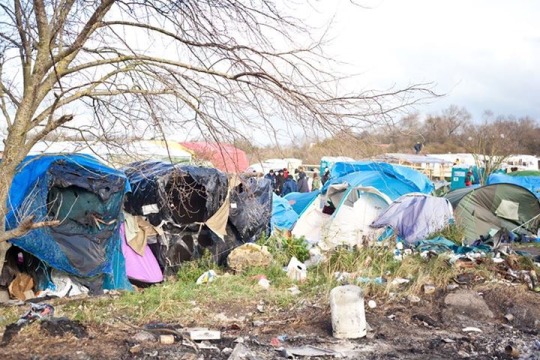
“We build”, those two words relay the surface spirit that keeps the people in the camp going. Their hope may plummet, but they refuse to be defeated and will carry on in the face of adversity, even when it looks hopeless. Although with the tough multi-million pound fencing, enormous police presence, temporary detention punishments, unclear plans for the camp, Paris attacks and the world on the brink of war, can it look any more hopeless?
The fire in Eritrea

Around the corner from him, a large group of people were taking apart another collapsed, wind-damaged shelter, reusing the parts to create a new home. Behind them was a large expanse of scorched earth. It reminded me what No Mans land looks like during war. In the background, a solitary tree with a blackened trunk and in the foreground, a mess of burned possessions.
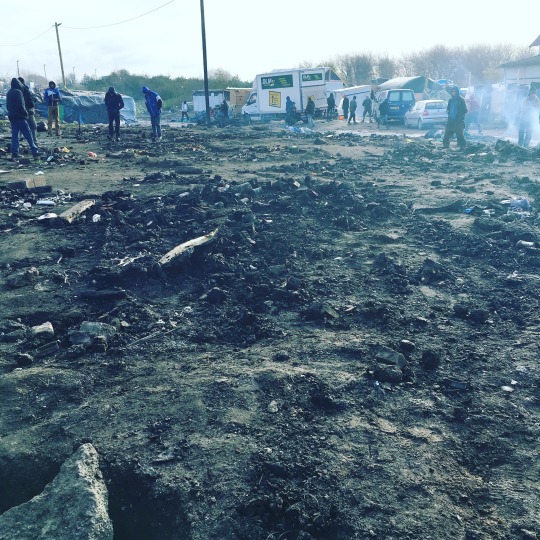
This had been the heart of the Eritrea district, right next to the huge church. The night before this area suffered an intense fire, wiping out 50 tents and putting people in hospital. The blaze had been intense and all that was left were the fire pit craters, carved into the mud where homes had once been.
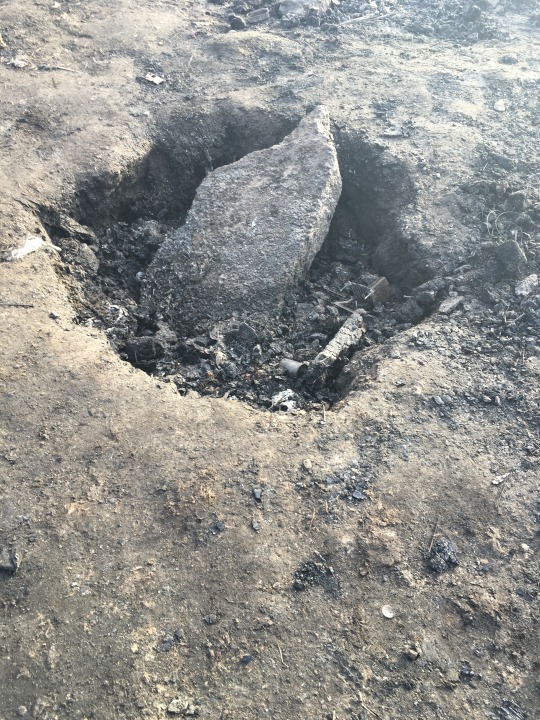
As we stood shocked at the lookalike war zone in front of us, a man approached. He looked lean but strong, wearing fatigues and a big coat. He pointed to the charred heap next to us and said, "My home. Gone. Eight people." He shrugged and smiled but we felt his despair.

He was a young Eritrean soldier who had walked across Europe to Calais, like many in the TV footage we see on the news. "So cold here. I am from the Sahara with hot sun. I am not used to the cold. So very cold," he shivered. He was joined by two friends and told us he had been in the camp 20 days and this area had housed newish arrivals. He told us, "I want to go to England. My brothers and sister are there and I want to be with them."
The gas problem

He explained that the camp fire was a result of an exploding gas canister. Just a few days before there had been an intense fire in the Sudan district, caused by a candle which had ignited a tent flapping in the wind. So two large areas had been wiped of tents and the urgency for shelter is obvious as winter approaches.
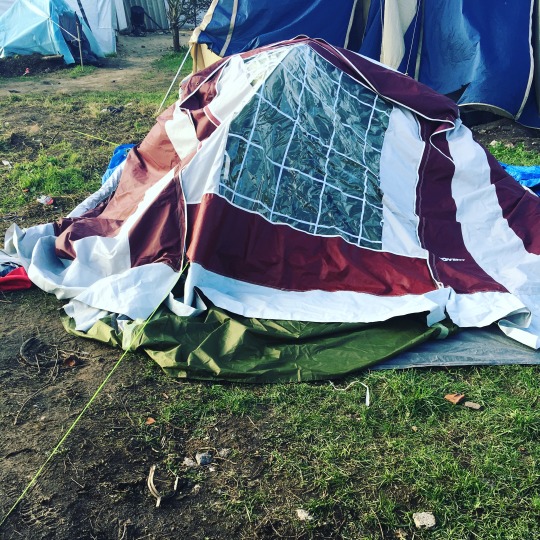
Gas is a huge problem. UK gas stoves are brought over but need connecting to French canisters or canisters are kept on uneven ground and they also leak. Gas is heavier than air and it sinks to the ground waiting for a spark. It's a dangerous business keeping warm and cooking. There are gas specialist volunteers who work hard on safety but again it comes back to inappropriate donations (no candles please, only solar) and inventive solutions made from what little they have causing an issue.

The beacon of survival
We asked the soldier what he’d do next and he said he'd rebuild. We joked he could build a high tower just to see England. Behind him people were clearing up the ashes, playing football in the embers and salvaging belongings. The church was in service, the air ringing with the sound of beautiful and resilient singing. It reminded me of the sounds from Paul Simon's Graceland album. Somehow the church survived this night of doom, even though the fire burned close. As the sun started to sink, it stood proud and shining bright white in the smoking landscape.

We asked the men where to find the Ashram Kitchen and they debated with each other for a few minutes before pointing up the road. We said our goodbyes, their hopeful, kind faces fresh in our minds as we headed for our volunteering duties, cooking for the masses.
As I write this, I realise the impact visiting the camp has had on me personally. I asked my fellow volunteers if it was normal to feel tired, slightly removed from my surroundings, hard to concentrate and as if I was in a fog. Those more experienced than me, said these are the fallout symptoms and the biggest one is being unable to stop thinking about the size of the place and the hurdles these people face now and in the future.
I want to return soon and I hope that this teeny, tiny little bit of help brings comfort to someone who is sleeping out in that camp, walking in the mud and feeling forgotten.
As one former refugee said on Facebook today: “I remember when I first arrived in Calais from Syria It was a nightmare. It was June at that time...I spent around 2 weeks there and It was one of the most difficult times. I was lost and worried. I remember spending 2 weeks there sleeping under the rain, having one meal a day and never changed my clothes.”
Read my other posts about children in the camp and inappropriate donations.
#calais#calaisjungle#calaid#volunteer#volunteering#welcomerefugees#refugee#refugees#morethanarefugee
0 notes
Text
The children of the Calais Camp
The first thing we saw as we left the motorway to enter the camp was a police van and a French riot officer. He looked like a law enforcing armadillo, with his shoulders encased in armour plating and rigid, bionic legs. It's intimidating, which it's meant to be.
We knew the atmosphere was tense in the camp. Only a few days before, the families in the camp had suffered exposure to tear gas after a peaceful demonstration about their plight. Kids were taken to the first aid areas with respiratory problems from the gas.
But there was fewer police than expected and they didn't ask to see our camp pass, given to us by L'Auberge des Migrants. The passes are like gold dust and it's hard to know when the police will ask to see them. Just a few days ago the kitchens had made hundreds of jam sandwiches but were refused entry to the camp to give them out.
Life in the camp

As we drove into the camp, people on bikes cycled past and it was busy with people. It reminded me of Oxford Street on a Saturday except these people were busy surviving. Groups were working to salvage dwellings after fierce winds the night before wreaked havoc. I watched as they worked together to make good the heaps of twisted tents, wooden struts and tarp. People were carrying paper bags stuffed with what looked like naans, or carrying heavy containers filled with water.
The road snaked infront of us, heavily pitted with daunting mud dunes and craters of rainwater. How long before this becomes impassable for the volunteers? As we drove, there were waves and smiles from residents as they peered into our car, hopeful about the contents. The camp had suffered gales and a huge fire caused by an exploding gas canister the night before. The need for food, shelter and warmth was acute.

We drove to the Sudan district, looking for the theatre dome, an arts project supported by UK theatres. We got lost. The camp's geography had changed rapidly in just a month. Now there is a mass expanse of flat mud in the middle of this district. This is where the government asked 400 tents to move before they bulldozed it smooth.

This space is designated for the government's new sub camp for women and children. Metal containers will arrive soon to house them. No one knows when or how it will work. The dome was in the way and had to relocate with the 400 tents. The vast empty space is like a scar and the tension caused by the government plans for the camp is apparent when you talk to volunteers.
Supporting the medic caravans
As we turned around and started our journey to find the new dome location, we drove past two medic caravans and one was open. We'd seen a request for cling film, disinfectant and TCP to help treat burns. We delivered a bag full with those needed items plus Ibuprofen, Paracetamol, cotton wool and Sudacream.

We chatted to the three volunteers inside who said they really needed paper dispensing cups (like the ones you put sauce in at McDonalds). They said they haven't treated any children and, as if on cue, there was a knock at the door. There was a man who pointed to an unwell boy of about four years old. I thought he was pushing a bundle of blankets in the pushchair before I realised they were keeping a baby warm.
That's another thing that has changed since our convoy last month, there are many more families and children. This is not surprising as 25 people are arriving a day at the camp. There are now 6,000+ people living in this sodden landscape, tents and structures laid out as far as you can see.

Good Chance Calais
Earlier in the day one of our team had delivered our 20 loaves of bread and dozens of eggs to the family area, so this is where we headed again. On the left of this zone we found the theatre dome, which is run by Good Chance Calais who put on arts activities in the day and house families at night who lost their tents in the fires. Next door is Hands International which is inoculating residents against disease. On the right was the women and children's centre and the family wellbeing centre.

As we parked up, people began to surround the car, asking "Line?" They were wondering if they should queue for a distribution. We explained what we had and showed the kids' supplies. They nodded and looked crestfallen. One man joked: "I can be child!"

We walked inside the dome lobby - the ceiling covered in brightly covered scarves found around the camp. We looked at the photography exhibition which expressed residents' feelings. It was really moving.

Outside a boy was hitting a ball in the air with a ping pong bat and a girl was clutching an envelope covered in stickers. More Syrian children appeared and they eyed up our carrier bags. We showed them our little fluffy mouse beanies and the kids' faces lit up with bright eyes, "Very nice, teacher!" The children squished them and flashed their smiles, blackened teeth stumps revealed. Our hearts tightened as we realised these children obviously have very little access to healthcare.

As they ran off, showing us the way to their friends, we noticed they were wearing trainers that were too small and the backs were trodden down as they slid around in the deep mud.
The family centres

We followed them to the red and yellow container which offered a place for the women and children. The sign at the entrance said it all and I took a photo. Liz, the centre's volunteer, shouted at me to put my phone away. "No photos here. I promised the women and it's important they are protected and feel safe." I apologised profusely. But this sign is important. Our team had chatted in the cash n carry about sweets and we opted for oranges and apples for the nutrition instead. Liz said: "Fruit is much wanted and they fight over it. We get some everyday but we could never have enough." Candy is not helpful.
We took our boots off and entered the container to hand out pens and paper. The children were so excited about the art materials, scrambling to grab some and sharing with each other. The container was warm with a wood stove and women and children were huddled in sleeping bags, talking with each other. The children had dirty faces from breakfast. It felt calm and safe for them. An oasis compared to the nightmare outside.

We headed to the wellbeing centre where children and men were painting a large board which would become the ping pong table. Alice, the volunteer overseeing the project, welcomed the pens and paper, and we handed out mice beanies to the young kids and bubbles to the older kids. The men asked for guitars with a cheeky smile, a nudge and a laugh. When we offered the boys the mice, they were disinterested and a man said: "They are men now." I watched the boy paint his national flag on the board and accepted that children don't stay children for long here.

The arts are so important to people in the camp, helping them express themselves and paint their stories. Expression is an essential part of being human and this work is vital. But Good Chance Calais and its artist in residence, Chav, (of whom I will share more about in another post) are running very low on funds and desperately need canvas, hardboard and acrylics.

We went back to the dome and met volunteer Rowan who was over the moon with the supplies and the instruments in particular. Percussion was much sought after as it meant people without music skills could join in easily.
She said the new location was damp and they often had water running through the centre. She pointed to neighbouring tents, now a mass of flattened nylon and metal. "I helped put these up and they were solid and bedded in. But nothing is a match for this muddy floor and weather."
Planning is the one helpful thing you can do
One thing we took away from our planned direct distribution is the projects have to know you are coming. We contacted the kitchens and theatre in advance. We also asked again before getting it out of the car, just in case the situation had changed, which it often does.
Advance notice is vital because storage is minuscule and they wouldn't be able to process large amounts of stuff. It's best to give to the warehouse to distribute when needed. I saw volunteers dragging bin bags of inappropriate stuff back to their cars. The project workers are the frontline and they haven't got time for ego projects.
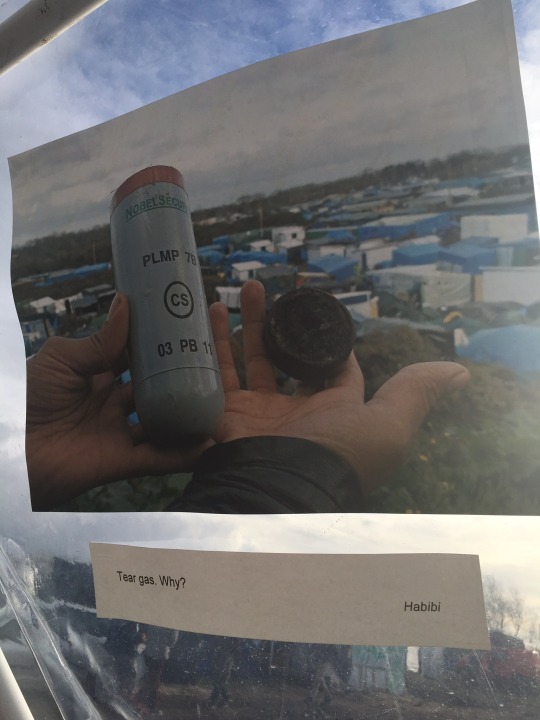
We said our goodbyes to the children, some wearing fleece bear onesies over their coats and they roared goodbye. I am left with their image in my mind, beautiful liquid brown eyes and hair as they laugh while playing in the mud, charming volunteers of their supplies and tugging on our clothes, "Teacher."
I don't have the answer to the refugee issue but these children shouldn't be here, caught up in gas explosions and tear gas or unable to get basic healthcare. Yet they are making what they can from it and that was truly humbling.
I didn’t want to take my own photos of the children, but I will write more about the camp, dome and Ashram Kitchen. Read here about inappropriate donations and how much they hinder the grassroots movement here.
#calais#calaisjungle#calaid#goodchancecalais#volunteering#volunteer#morethanarefugee#refugee#welcomerefugees
1 note
·
View note
Text
Whitstable Convoy to Calais
When grassroots donations help and hinder at the same time
Yesterday, three cars left Whitstable full of donations for the Calais Jungle. One car was full of fresh food, essential supplies (such as oil), medicine, arts supplies, bread and eggs. Another was full of tins donated by locals. The third was full of tents, blankets and essential clothing. Our team volunteered in the giant warehouse sorting donations and in the Ashram Kitchen, preparing food for camp residents.

Some of the group had been before but for some, including me, it was our first visit although we’d been involved in sending out a convoy in October and fundraising in our local town.
The warehouse
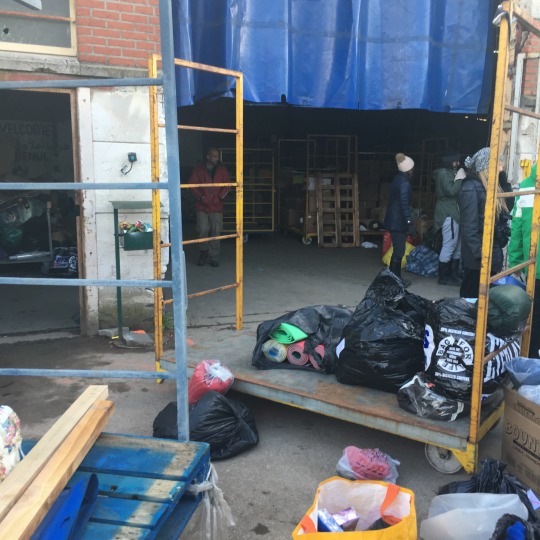
Nothing could have prepared us for the enormity of the donations warehouse in Calais, which has recently moved to bigger premises. It was an enormous hanger and organised like a Tesco distribution centre, bustling with volunteers.
Vans pulled up at the front to unload, wheeled trolleys were pushed forwards to receive the boxes which were then delivered to the main sorting area. The processing area took up a huge section of the warehouse with a clothing mountain up to the ceiling. I was told, “This was double the size. We are winning.”
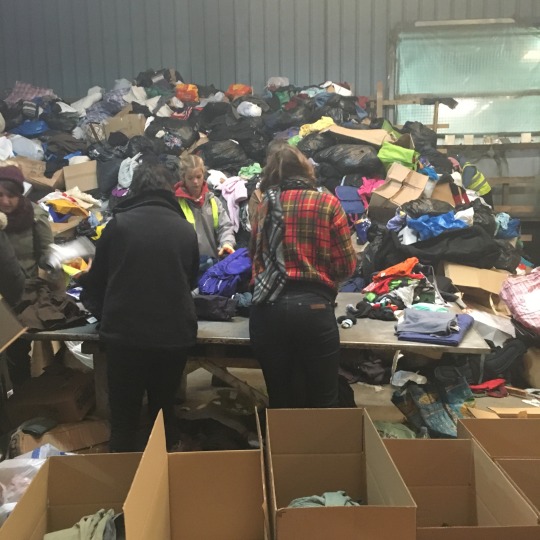
The warehouse is full of volunteers of all ages, from the retired to students, men and women, and from all over the UK - Yorkshire, London and Bristol were some of the locations of the people I talked to.
Those working the clothing mountain packed the clothes by item type into boxes. The boxes were taken to the grading area for quality control. My briefing was, “No holes, rips or stains. They must be quality. Think about what you would wear in winter. Nothing above 36 waist or a large - the men are slim. The women are also small. All unsuitable items go in the clear plastic bags. Suitable items go in the boxes, each one labelled per item, size and gender. Any vintage stuff goes in the box for selling.”

He pointed to the boards on the wall where examples of unsuitable stuff were pinned: skirts, giant bras and boob tubes. I saw examples of these items trodden into the mud all over the camp. This isn’t about ungrateful refugees, it’s about the grassroots not thinking though what they are doing.
We went to work for a while sorting the boxes. People taped up the full boxes of good stuff so it could be sent for labelling. Once labelled, the boxes are stacked in the right place in the racking system ready for distribution. The warehouse does not want to store items and wants to ship out as soon as there is a need.

Other people tied up the bags of rubbish clothes and took them away. More people collapsed unused boxes so they could be reused again for the racking system. This is grassroots logistics and it’s highly ordered.

I know what it’s like to be faced with a donations mountain to sort, we did a clothing collection locally and we also had a heap as tall as me at one point to sift. It’s backbreaking work and soul destroying as you process another load of stained work shirts.
The quality of clothing was far worse than we had in my town: 1960s polyester slacks (some with gaffa tape over holes!), XXXL work shirts, 1980s ski jackets which are barely windproof, clothes with stains and thin, formal clothing.
Inappropriate aid

The clear sacks of unsuitable stuff are sent to the front of the warehouse to join a huge mountain. I saw a few bags of Ugg-style boots, which wouldn’t last five minutes in the camp’s unforgiving, wet and muddy terrain. These clothes are destined to go back to the UK for “Cash for Clothes”. But this requires volunteers, time and money for the transport, crossing and petrol. It’s an ineffective way of raising money and using volunteer time.
Here’s the dilemma. We all want to help but what is the best way to help? You can see why they get so much stuff that is useless. It's relatively easy to collect locally a bunch of stuff, drive it over to Calais and tick off the box which says “I have helped”. But this is where the nightmare begins in terms of the sheer manpower you need to sort and distribute this stuff so that refugees receive the right kind of aid in a safe and consistent way which preserves their dignity.
The coordination problem
It comes down to communications and people informing themselves before acting. It’s hard to understand but no one is in control of the camp. There are no official charities such as the Red Cross or French government officials (other than the separate Jules Ferry Centre). There are French Non-Government Organisations, such as L’Auberge des Migrants, who offer the warehouse to process donations, run direct distributions and help others distribute safely.
The NGOs have forms to fill in so they know who to expect, when, what items and how much manpower they need to put in place to receive the stuff. Social media has played a huge role in streamlining and getting the message out there about what to bring. It’s made me see the value of Facebook in a completely new light. The grassroots movement would be very difficult without Facebook.
But despite the information on social media or the NGO advice on the ground, many people drive into the camp and don’t heed the experience of others. Those that haven’t pre-sorted their van into item types and sizes, or ask residents to line up, end up causing tension and confusion which can spiral out of control. It erodes dignity and further leaves residents feeling powerless and like animals.

The camp has suffered two fires in nine days, wiping out areas of the Sudan and Eritrea. The need for tents, blankets and sleeping bags is acute - huge pallet areas in the warehouse are empty as they try to deal with the 25 new people coming into the camp every day and existing residents who have lost everything again due to fire or high winds.
The wrong kind of aid is a huge problem - the camp is littered with flat, dainty shoes and clothing unsuitable for winter weather. The French NGOs and the longterm volunteers make it clear each week what the current needs are to help people send the right stuff - it’s food, wood and shelter at the moment. But this is on websites and social media and not all the groups sending over donations are looking at Facebook or even know this bounty of information exists.
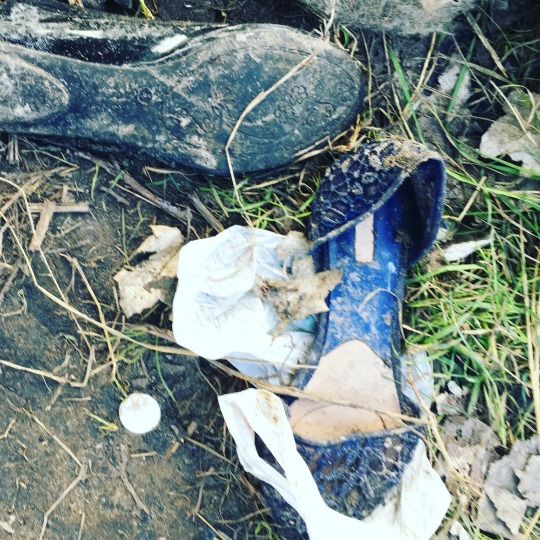
What is the answer?
The volunteers are also hungry and dirty as they put themselves last - their schedule is punishing and leaves little time or energy for self-care. One who was camping there hasn’t washed for two weeks and has only eaten nuts for the last few days: “I need to go to a hypermarket. I want to eat proper food again. I can’t bear to see another nut.” The longterm volunteers look exhausted. Day after day they deal with camp fires and inappropriate donations, even volunteers who take matters into their own hands and make the situation worse.
I don’t know the answer but for time being, these volunteers are trying to plug the gap between the question and the answer. The camp residents rely on their stamina to hold on while the solutions are discussed in the EU and beyond. Let’s hope they can hold out both in the warehouse and in the camp.
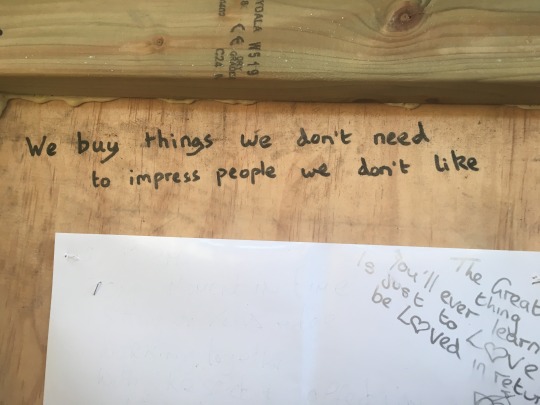
I will write soon about life on the camp and volunteering for the Ashram Kitchen.
#welcomerefugees#calais#calaisjungle#refugee#morethanarefugee#volunteer#calaid#volunteering#laubergedesmigrants
1 note
·
View note
Text
What the Dreamland revival experience feels like

My childhood was filled with Dreamland, a rambling, noisy fun park with a soundtrack of screams from the thrilling Looping Star rollercoaster or the Mary Rose when it hung everyone upside down, showering those below with coins from full denim pockets.
It was exciting and terrifying. It was also filled with what we call “proper Margate” people, from the powerful, grease-stained ride operators to the territorial, aggressive teenagers wearing high 80s fashion. It felt dangerous, but in a safe way.
The screams faded and Dreamland become unloved, empty and finally disappeared in flames. The site, which used to be the beating heart of Margate, became its tar-blackened lungs. After a battle between the owners, the council and Margate residents, the site was rescued. Funding was found and a new reimagined Dreamland was born.

From the age of 12, I used to do a £5 “ride all day + train” deal. In this adrenalin paradise, I’d eat giant red sugar dummies, go on the Enterprise nine times in a row until I was sick and secretly check out the local boys.

It was the first place I heard New Order’s Blue Monday, at decibels that aren’t legal in a public place now. It was a venue that crossed all relationship boundaries. I went there with family, primary school friends and mates throughout my teenage years. I even took my little sister there.

When I was contacted last year by a recruiter about a new Dreamland PR and social media role, I went for it. It’s not just Margate that needs Dreamland to be a success, it’s almost a pilot regeneration project for our country’s seaside towns which need to transition to survive. Sadly, my professional reconnection to Dreamland wasn’t to be this time around.

When the new Dreamland tickets dropped online, I got them in the first hour.
But I was under-prepared for the rush of emotions when I went to the ticket barrier and walked through the old arcade and dodgems area. As I handed the tickets over on the park’s first opening day, I had a huge lump in my throat.

For years this place has looked unloved, a symbol of the mistreatment Margate and its people have faced for so many years as an under-invested dumping ground for unloved children and unwanted refugees.
The town has been left to get on and make the best of it. And that’s exactly what it has done. Despite being on the cliff edge, they have scaled the summit and the view looks amazing. Now they have a world-class art gallery, reimagined Dreamland and a vibrant local arts culture.
They’ve done it.

The former wasteland is now vibrant and full of people. The staff are skilled in radiating happiness and the air is full of hope. I couldn’t stop the tears running down my face.
We’re with you Margate. All the way.

1 note
·
View note
Text
Telegraph Digital Leaders conference and the industrial internet
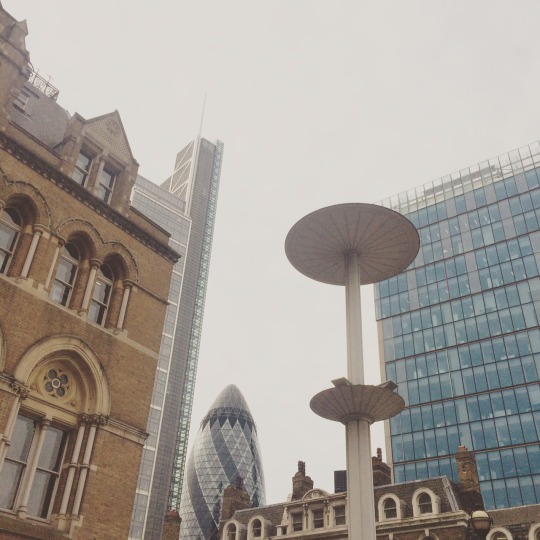
Thanks to a ticket from We Are The Future, I headed to the Telegraph’s Digital Leaders conference in Bishopsgate last week to hear how technology is driving economic change. The event had an impressive line up of high-ranking speakers and here are some of the points I’ve been thinking about since:
Statistical storytelling is in demand
Mark Elborne, CEO, General Electric UK& Ireland, said technology advancement has seen General Electric shift its business from mechanical engineering to software and data analysis. It’s now one of the biggest software companies in the world.
General Electric said using and understanding data is now part of our working lives. The challenge is connecting people to data and data to machines. Integrating the physical with digital is the industrial internet of tomorrow and will create more effective machines.
Machines may replace some of the jobs for our workforce, but there will be new roles and people will still drive the next industrial revolution. The friction is equipping the workforce with the skills needed, both at school and at work. We all have the capability to grow our knowledge and having a manual job shouldn’t be a barrier to a new career in data analysis.
Being able to predict and prevent downtime is at the centre of the industrial internet. Unplanned well downtime or aviation delays cost millions daily. Being able to analyse data ‘just-in-time’ will flag worn parts, market disruption trends and prioritise fixes.
When it comes to data scale, my mind was blown when Elborne said a wind turbine has 20 sensors on each blade and a typical wind farm produces 100TB of data daily.
Stop copying what your competitors are doing
Narry Singh, MD and head of digital strategy, EALA Accenture, said stop comparing your app to your competitors’ apps. There is no point because customers compare your technology to their general experience of other technology. Look at those who offer the best user experiences instead.
Service transformation needs quick decisions
Everyone has claimed the term ‘agile’ and it’s done some damage. Marc Lien, director of innovation and digital development, Lloyds Banking Group, said nothing is agile until it is shipped and customers are using it.
They’ve approached digital transformation in a similar way to the Government Digital Service’s experiments. The bank redesigned 10 end-to-end customer experiences, including online lending. The resulting services have disrupted the car buying and mortgage applications markets in the process. He said success relies on working to understand how customers think and an organisation’s ability to speed up its decision-making processes.
The world has become complex in a decade
Ten years ago, the world was much simpler. Andrew Griffith, group CFO and MD, Commercial Business, Sky, said back then they only had one product and method of distribution – a box and dish. Now they handle 70 channels distributed across multiple devices and balance a broadband load which can hit 400,000 live streams for a single show. Sky’s apps have been downloaded 81 million times and there are six million customers registered for watching TV regularly via mobile.
Linear consumption – sitting down at 9pm to watch a show in real-time and then what follows after - is decreasing as behaviour changes. Video consumption has increased by 20% in the last five years and technology means shows are being watching by more people than was possible with the original format.
The hit series, Fortitude had 1.7 million views for the real-time original format show, then gathered another 1 million views from Sky+ in the first week plus another 1 million within that month. There were 450,000 views from mobile and tablet users and 375,000 watched it on demand. It wouldn’t have hit nearly as many people without multiple distribution choices.

Reach isn’t always about linear customer alignment
Stephen Kneebone, CIO, Nissan Europe, said strategy wasn’t about interacting with customers at the point-of-sale anymore. You need to seed wider than ever.
Eight years ago, Nissan collaborated with Sony for a competition which asked people to show off their racing skills using a PlayStation game. The prize was to win the chance to do it for real in a 24-hour race.
It’s become a fixture and now they have a pool of experienced drivers. It’s branched out into an academy with Formula 1 engineering opportunities to develop, test and improve vehicles.
Customers will make your product their own. Literally
Luke Vinogradov, VP digital, Europe, McDonald’s, said the company has an interesting challenge with it being a place, brand, icon and a franchise and they are working at stitching that together to provide a seamless customer experience online and offline. They are just starting to get to grips with digital services, rolling out kiosk ordering across Europe and looking at app ordering.
He said that customer interaction is not about comms verses service channels. Customers don’t care about channels, only their needs. These needs can be clearly seen in the large McDonald’s menu hacking community who can demand that their creations become reality.
It’s not enough to understand statistical data
Simon Morris, director of marketing EMEA, Adobe, said their main offer has changed from buying an application to offering subscriptions on the Creative Cloud. They spend 74% of their advertising budget on digital, which is much higher than most companies. They need data scientists who are also great storytellers so they can fully understand the narrative behind the data.
Even data scientists can’t always tell you what’s going wrong
Heather Smith, UK marketing director, Aviva, said listening to customers often sits in the call centres of organisations. They can tell you where the digital process is broken, as they pick up the pieces. They also often have brilliant solutions to fix these processes.
#industrialinternet#internet#revolution#digital#technology#Nissan#McDonald's#Aviva#Sky#GE#industry#assetmanagement#datascientist#data#statistics
2 notes
·
View notes
Text
Surviving content shock
Last week I gave a talk about ‘overcoming content shock’ for Techmap’s regular meet up in London.
It’s something I think about all the time.
How do we stop feeling overwhelmed by demand, stakeholders, data, learning and frustration?
Knowledge plays a huge role in managing the feeling of being overwhelmed because it helps us:
Prioritise demand
Push back on stakeholders
See the story behind the data; customers/users/people instead of numbers/statistics
Collaborate more which means we learn a little about a lot
Feel empathy with disciplines for smoother projects
Here are the key things I talked about...
1. Shock of the new

I noticed a huge change in content, communications and community around 1995 when I started talking to people in online forums. It was around 2000, when I was a director at a PR agency, when it began to change client work.
We were moving from traditional content distribution (press releases by post) to online content and real-time feedback. The audience’s reactions informed content in a way that we’d never seen before. We’d gone from broadcast to engage.
At the time I was a consultant news editor for the Department of Work and Pensions and the European Social Fund (ESF). They needed to communicate policy changes, share success stories and increase project outcomes (more people in employment) for ESF-funded projects. Broadcasting wasn’t working and they wanted to get two-way feedback going.
We launched an enewsletter and website which had a listening ear symbol at the end of each story with an email address to encourage project managers to email in their questions, stories and feedback. This was answered personally and swiftly by the ESF team.
It sounds laughable now, but it was the beginning of what we now call ‘engagement’, the ask, listen and change cycle.
2. Client need > user need

We’re facing a content revolution . We’re moving away from writing by committee (hallelujah!), longwinded approvals processes and publish and forget cycles. Instead we’re looking at a content process which is never finished and constantly evolving.
The new cycle - publish > test > feedback > iterate> publish> repeat - is not just for web development. It’s the future of agile content production - the sane way of dealing changing user needs.
The Government Digital Service (GDS) is ripping up traditional models of production for its digital services. Their motto is "digital by default" and they believe striving for perfect is futile. Their influence is worldwide and across all sectors. Have a look at their service design manual.
Revolution is painful and messy. Clients are struggling to move from the safe zone of ‘published perfection’ to the risky unknown. It's our job to educate and convince them to make the leap.
In the last few months, I’ve found this diagram can help when clients want to reuse material or create assumption-based content. It puts user need at the centre of content creation and helps push back client or stakeholder needs.
It’s our job to think like the users, ask the questions they might have and answer them with logical, easy-to-find content which doesn’t need a jargon buster to understand.
3. Knowing me, knowing you

Since 2000, the biggest change we’ve seen is around data. It was expensive to get close to the user 15 years ago. It involved specialist agencies, telephone surveys and mega reports, which clients simply didn’t want to pay for very often, if at all.
I remember creating copy for websites, intranets and CD Roms (*shudder*) without having to analyse data sets.
Now we can get data for free or cheaply and it’s our starting point for content strategy. We want to understand who we're trying to target, their motivations and how they connect to us.
The downside is we’re drowning in data and we can forget that the numbers and statistics are real people. Personas help us build a story for each user group and they are vital for matching content to the audience segment.
To get closer to users, brands such as Tesco and LUSH, have set up agencies outside of the corporate structure to use data to design better services online.
4. Sowing the seed

Content distribution is also shifting and social media is the new postal service. Yet social media constantly changes the rules and we’re trying to keep up. Organic reach is dead, platforms are flooded with content and it’s harder than ever to get noticed. We need budget to really make the most of these platforms, but clients have yet to ramp up their digital spend adequately.
There’s also a rigid focus on reaching the perfect core audience via social and a fear of wasting spend on non-core. We need to help clients feel confident in casting their social net wide, so they make the most of people’s broad, personal networks.
Think about ALS and the ice bucket challenge. How many of those people were directly following or interested in ALS? Not many. Yet millions of people completed the challenge. Only a small proportion donated to the cause but it illustrates how a non-core audience worked with the core audience to spread the message through critical mass.
Critical mass is making money for entrepreneurs. Social Chain has set up comedy and parody accounts and attracted large followings - around 209 million. They can now get hashtags trending on Twitter just through sheer follower volume and are working with major brands.
This diagram shows how we reach core users through the different channels (nope, I am NOT calling it a funnel). Social is the biggest fishing net, followed by online ads. The next layer is those who've opted to hear from us using our databases for email and direct marketing. Key messages blasted out on social/ads/direct marketing are reinforced by earned media, the reviews/endorsements. All this activity gets us up the mountain to our perfect core audience. You can see we’ve had to use non-core to get to them.
5. Sharing personas

The change in content distribution means it’s important to think through why someone would share something.
Sharing involves complex motivation triggers.The image above shows research by the New York Times into the personas of sharing. It shows that the desire to share goes way beyond offers of a prize or money. Increasingly people want to be directly involved with brands.
In 2012, I was at SNCF and responsible for increasing InterRail ticket sales using a social campaign with a small budget. By getting Facebook fans to design a mystery tour for a journalist, voting on destinations, they were far more engaged in the campaign which was reflected in a sales uplift.
Advocacy and community play important roles in content strategy. If you ask for help from others to spread your messages, then you have to offer rewards. Giving your most active users a recognisable elevated status, such as a badge or title, is a tried and tested way of rewarding interaction. These are things money can't buy and have to be earned, which makes them attractive.
One Direction, Taylor Swift and Justin Bieber have amassed enormous communities by rewarding fan content marketing. Today’s official fan forums or apps swap engagement for coins or similar, this earned community status can be exchanged for exclusives. This strategy creates an army of authentic content producers who respond to official content in real-time. It’s powerful when you see it in action and worth far more than any advertising.
6. Collaboration

With data overload and a constantly changing content landscape, it’s important to say goodbye to bad ideas. It’s quite a hard thing to do, as we’re programmed to think our own ideas are good or the best. But you’re the biggest hindrance on a project if you can't recognise when something isn’t working out.
Working in a multi disciplinary team with a broad range of skills helps you identify bad ideas more quickly than if you work in silo. You need people to challenge your ideas, question your thought processes, improve on your creativity and help you understand when you’re heading down a dead end.
Working closely with other disciplines - design, digital strategy, analysts, UX, project managers - grows knowledge. My entire approach to work in the last year has changed as a result of working with and being challenged by UX superdude, Mike Jongbloet.
Instead of hiding that I am a generalist, I’ve come to understand that there is a huge advantage in being one and having knowledge about a wide range of disciplines. It makes you empathetic, useful and collaborative on projects.
In fact growing knowledge is the key. Being a lifelong learner, remaining curious, ditching the bad and sharing what you know are the only ways to survive content shock.
The slides
I met some great people at Techmap, including the other speakers, Doug Kessler and Gareth Case. B2B content ace, Doug spoke about the importance of writing about what you know and what’s interesting to users, as well as giving the audience emotion. Gareth introduced the wonder of Turtl - one of the coolest things I’ve seen recently. There’s a great write up here or you can see the slides below.
techmap: Overcoming Content Shock
from
Klaxon
0 notes
Text
We need to talk about Instagram’s spam
Last year I broke the golden rule of social; I posted photos of my food on Instagram as part of the #100healthydays challenge.
My only saving grace was I set up a dark account so my friends had no idea about my visual food diary uncouthness.
During the 100 days I shifted 35 pounds (yeah, allow me a little bit of glory) but I also found out some things about Instagram on the way…
1. Super swift likes on publishing

Pretty early on I noticed something weird was happening when I uploaded a photo and then hit ‘share’. I’d start receiving 'like’ notifications before I’d fully clicked away the image, almost simultaneously. Were people taking part in ‘whack a mole’ style liking games on Instagram?
A developer mate said that Instagram has probably enabled fast-track API access which means accounts can react quickly. Upon investigation, it was clear that the accounts doing the super swift liking are of dubious quality, which brings me onto the next observation...
2. Let’s have some bread with that spam

The spam quota is ridiculously high on Instagram. It reminds me of Twitter about five years ago when there were a lot of lovely ladies wanting to show me a good time.
On Instagram, certain hashtags are triggers for an avalanche of 'get more followers’ or prompts to buy 'miracle’ wraps, powders and pills to make you lose weight quickly.
Even if you’re a committed Instagram community member and report each spam account, another quickly appears and fills the space of the deleted profile.

It’s completely ruining the platform, with posts littered with spam comments.
Instagram says it is tightening up its spam detection, but it has a seriously long way to go before it has it under control.
3. Fake comments galore

I noticed that when I slipped up on my diet and had chocolate, the comments I received on posts were the same as if I’d posted a healthy food image. It seemed that people were posting comments which didn’t relate to the image shown.
I did some research and found companies offering to get you more followers by using fake comment tactics to up your profile follows. I used a free trial for 24 hours to see what happened.

I was told commenting and liking more accounts would mean more follow backs. I allowed them access to my account and they started to post minimal replies, such as “nice pic” or “awesome” on loads of accounts. It’s automated, so often the comments counter the sentiment of the image, for example over enthusiastic happy words for a sad photo.
4. Styling and photo treatment ups interaction

You’d expect a well stylised photo to get more likes than something taken off the cuff. But I found that food arranged in symmetrical patterns got many more likes than just an attractively styled plate.
Images that were manipulated also got more likes, particularly those that were made brighter, saturated with colour and sharper.
Photos without a filter got the most interaction, although Brannan and Mayfair filters seemed to get plenty of likes.
A wide variety of paper straws and jam jar glasses also won me extra followers.
5. Words really matter

Images with a full description of the image content (listing each food item) and cooking method got more engagement than those that said simply 'dinner’, even if the picture showed an obvious meal such as poached egg on toast.
Trend ingredients or gadgets also upped the likes, such as chia seeds or Nutribullet.
6. Tag it up and then some

I’d read that the more tags you use, the fewer interactions you’ll have. I found the opposite to be true.
I used around 20 hashtags for my posts and received about 25 likes per images on average. When I used fewer than five, interactions dropped to fewer than 10 per post.
7. The fitfam is mighty
Despite the spam, fakes and nonsense product peddling, the fitness family is global, vocal and really supportive.
People are inspiring and helping each other reach their goals. There doesn’t seem to be much in the way of trolling and the vibe is overwhelmingly positive, which makes Instagram’s fitfam a rarity on social media.
Hopefully Instagram will sort out its algorithm and beast the spam into submission.
1 note
·
View note
Text
Croatia, Montenegro and Bosnia holiday review
1. Get to know Dubrovnik

Dubrovnik built its fortune on maritime trade and its name means “oak forest”. The trees are long gone, used for shipbuilding and destroyed by war, but the city’s medieval walls remain.
Inside the walls are narrow streets, beautiful old buildings made from white stone and deep terracotta tiles and many, many steps. The Adriatic’s green and blue colours are dazzling, almost unreal. There’s no need for Instagram’s filters here.
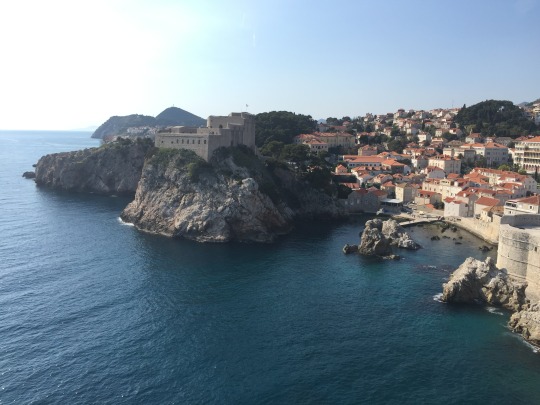
It’s astonishing that the city survived during the Homeland War in the 90s. The old city was under siege and sustained severe damage from shelling. The restoration has been sensitively done. If you look closely, you can still see pock marks from shrapnel on the buildings.
Like Bruges, Dubrovnik relies heavily on tourism and it’s full of souvenir shops brimming with normal holiday tat, silver and coral jewellery and traditional Croatian embroidery. It’s also a hotspot for Game of Thrones lovers, as the TV series was filmed here.
Look for the official Croatian souvenir sign outside shops and visit the Jewish quarter for jewellery or Kate Stojanović for embroidery (you’ll find her sitting near one of the harbour gates).
The city is packed with restaurants and boat trip hawkers, hoping to make the most of the day trippers. The staff around the main street and harbour can be quite reserved, but if you take a walk among the back streets, you’ll find a more relaxed atmosphere and friendly locals.

One shop owner explained the meaning of the local currency, Kuna. He showed the picture on the reverse of a coin and told us that it was a pine marten. Marten pelts were the unit of trade in medieval times but they are so rare, they're protected under Croatian law. The man laughed when he said that the souvenir we’d chosen was 30 pine martens.
2. Climb the old walls

It’s worth getting a Dubrovnik City Card (about £20 for adults), as it gives you access to the walls, key attractions, money off restaurants and 10 bus journeys. Kids under 12 go free if you’ve got a card and most bus journeys let the kids ride free (but a couple of drivers asked for an additional child’s fare).
You need to pay to get up to the walls and it takes a couple of hours to do a full circuit. The side nearest Mount Srd has the highest elevation with steep steps and low walls without safety rails, so keep hold of small kids. The Adriatic side has 130ft drops but there are fewer stairs to climb.
We went in low season and saw a few places where you can buy drinks as you go round. In full sun, it is blisteringly hot and without much shade, so take plenty to drink.
3. Ride up Mount Srd

If you can’t manage the city wall tour, take the cable car up the mountain. It’s around £35 for a return journey for a family of four. Add on an additional entrance ticket to the Homeland War exhibition at the top for a few extra pounds.
A great view of the Adriatic awaits at the 400-metre summit, with the Elafiti Islands in the distance. Stroll along the top near the giant cross for a scenic view without cable car wires in the way.
Fort Imperial houses the Homeland War exhibition. Walk around the outside to see the fort’s war damage - it was a strategic base - and pop inside for the exhibition which tells the story through photos, artefacts and video. You can climb up onto the roof of the fort too (just walk up the stairs, past mouldy and creepy unmanned floors).
4. Sail away to Lokrum
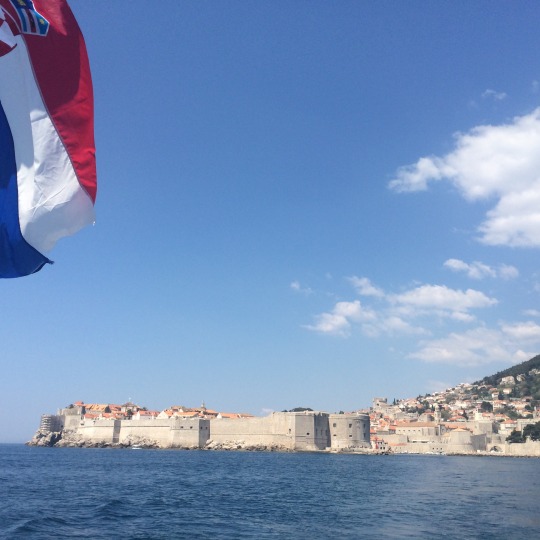
You can buy a boat trip ticket from the harbour. You can get over to the Lokrum island cheaply, around £15 for a family of four. Boats go every hour in low season and the journey takes around 30 mins. The last boat back is around 5pm.

Lokrum is a car-free and non-residential island, although there is an alarmingly large population of peacocks.
There are paths through the wood, which give welcome shade, to several places of interest. You can climb on the rocky shore to look for marine life, walk around the monastery or play on the outdoor gym.

The Dead Sea was a favourite, a secluded and peaceful inlet of water surrounded by rocks and a stone beach.
5. Walk around Lapad
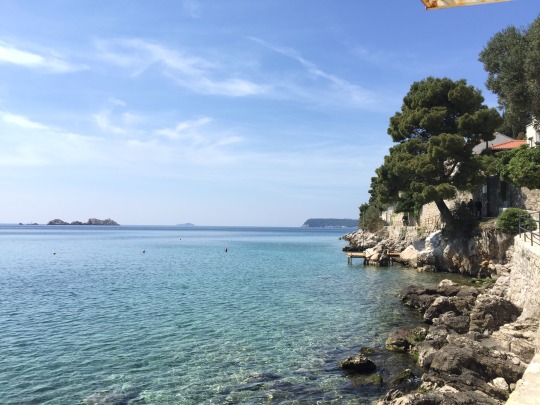
There aren’t any hotels in the city walls of Dubrovnik and only a few close by. Most of the hotels are in Lapad, a 10-minute bus ride away.
Plus points:
Break - a rest from the dense mass of tourists in the walled city
Beach - a pebble slope which is good for kids. Dubrovnik has a rocky coastline and there are few public beaches. Sea access is usually by jumping off concrete platforms built into the rocks
Walk - there is a lovely promenade around the bay and places to drink with great views
Price - this is where the cheaper family restaurants are
Ice cream - for the best, go to Slastičarna Sirena (Setaliste kralja Zvonimira)
Park - with play equipment for small children
Atmosphere - the people are really friendly
Location - you can walk to the port from here with its boats, galleon and markets
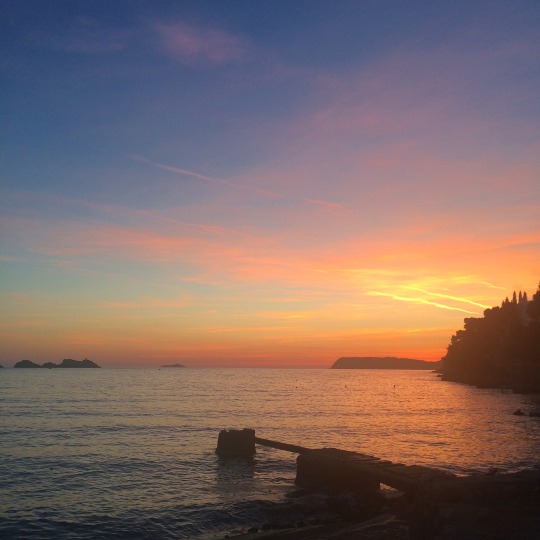
The downside: the Adriatic washes up quite a lot of rubbish and this is on the beach, the backdrop features hotel monoliths, it has a seaside tourist feel and there’s a lot of construction as tourism is on the up. Also, don’t let your kids climb the vintage beach slide into the sea. It’s rusty and has a thin bar at the top of the steps which is hard to see.
6. Soak up local culture
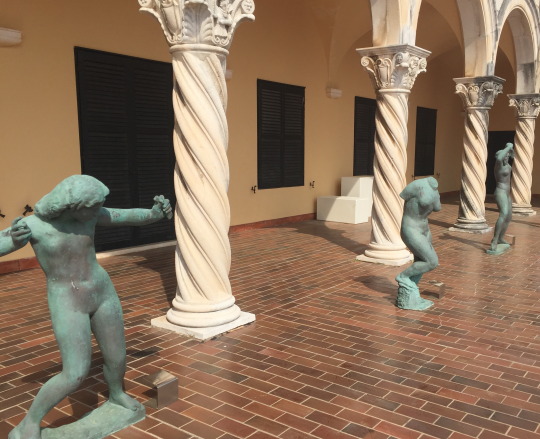
Worth a look:
Modern art museum - some interesting work and a terrace overlooking the Adriatic
City museum - see the original bronze sculptures which struck the bell in the city’s main tower
Old Synagogue and cathedral - stunning interiors
Fort Lovrijenac - a worthwhile climb
Park Gradac - head down to the rocks for an explore

Beware of these:
Maritime museum - small, dull and you aren’t allowed to lay a finger on the glass cases which is tricky with small kids
Aquarium - loads of fish in dank, dark and tiny tanks. Very depressing
7. Order seafood (and ice cream)

Food is not cheap in the old city and most of the menus showcase big meals rather than snacks.
If you’re on a budget, go to one of the supermarkets or bakeries (called ‘pekara’) to buy fresh baguettes. Get your ice cream near the entrance gate on the main street rather than the harbour. Yogomania (čubranovićeva 3) is worth a visit for frozen yoghurt and unlimited toppings. Beer is cheap (especially in the supermarkets).
A word of warning, fish is priced per 100g in the menu. A big fish is about 1kg, so around £50, and will feed a family of four. These are the places we liked the most:
Atlantic Grill (Ulica kardinala Stepinca) - head to this Lapad restaurant for great food and service. The deluxe seafood platter is recommended
Revelin (Ulica Svetog Dominika 3) - the place where we ordered a £50 fish but it was seriously good, with a fantastic view of the old city harbour
Lapad Grill (1 Ulica Mata Vodopica) - order the house grill for a huge and tasty portion of selected meats, fresh grilled veg and risotto
Blue Planet (Masarykov put 3) - fresh, cheap pizzas with your choice of toppings
Chihuahua Cantina Mexicana (Setalište Kralja Zvonimira 2b) - fajitas for kids and decent cocktails for the adults
8. See the old bridge at Mostar, Bosnia

It doesn’t look very far from Dubrovnik on the map but don’t be deceived. The road infrastructure is poor, mostly a single carriageway, and the journey takes about 2.5 hours. Native drivers don’t think twice about overtaking on hills and bends and often you’ll find a car on your side of the road.
But the trip is worth it.
Mostar is heavily influenced by its Turkish Ottoman Empire heritage, with mosques and a souk-vibe around its shops. Tiny shops are crammed together along cobbled streets and stuffed with painted china, Turkish slippers, brass tea sets, leather goods, wooden toys and jewelled boxes. There are plenty of WW2 relics for sale too.
The Stari Most (old bridge) joins the city across the river Neretva and was built by the Ottomans, a feat of engineering in the 16th century.
Mostar was the centre of a long fierce battle during the break up of Yugoslavia in the 90s and the bridge was destroyed.
When you talk to the locals, it’s clear the memories haven’t faded and there are still deep divisions. More than 20 years on, the city has plenty of damaged buildings and areas with mines. Yet it doesn’t feel unsafe, with newly built areas towering next to the war’s leftovers.

Make time to walk down to the river and sit on the slabs of concrete from the war. Here you get a good view of the divers jumping off the bridge for money.

The currency is the Bosnia and Herzegovina Convertible Mark but shops in the walled part of the city take Euros or Croatian Kuna.
9. Visit UNESCO Kotor Bay, Montenegro
Kotor is about two hours away from Dubrovnik and the road is in a pretty poor state in parts (although repairs are ongoing). Parts of the road have been blasted through the mountains and lorries which are too tall to pass under the mountain cut out come over onto the ocean drop side. It’s in my top five most scary road trips.
As with Mostar, it’s worth the ride.

If you look closely at the photo above you can make out a snaking wall zig zagging up the mountain and a castle at the top. This is the Kotor Fortress system in Montenegro which has origins going back to the 6th century.
The Balkans provide a giant, almost alien backdrop while Kotor’s bay stretches out in front.

It’s about €3 per person to climb the walls. You need to be relatively fit to climb the steps to the top, it’s the equivalent of climbing 155 floors and takes about 25 mins just to walk down. On a hot day, it’s punishing although the church provides welcome shade about a third of the way up.
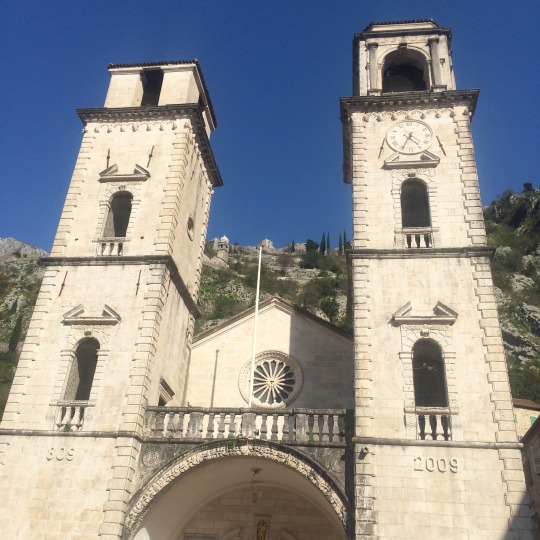
It’s worth walking around the town, with its ancient architecture. It’s very touristy but the restaurants serve a good selection of pizza and seafood and the people are outgoing and friendly.
10. Spot a cat

You can’t talk about Dubrovnik without mentioning that it’s home to a rather large number of street cats. Some even wait by the harbour for people who spend their lunch hour fishing and feeding them. We counted 110 cats in just one week. There’s a cat food donation box as you exit the city walls, so drop a coin in.
Dubrovnik is a brilliant location and gives you the chance to visit two neighbouring countries, each offering very different experiences.
#Croatia#dubrovnik#montenegro#bosnia#bosna i hercegovina#kotor#mostar#lokrum#review#travel#travelwriting#trip#gameofthrones
2 notes
·
View notes
Text
We're obsessed with recording our lives but what are we going to do with all this data?
Earlier this year, it was one of my best friends' birthdays.
She was 40.
We’re childhood friends, growing up together during tearaway teenage years; practising the running man, finding meaning in the world of De La Soul, sharing heartbreaks and breakdowns. We’ve been weaving in and out of each other's lives since we were 12.
The big realisation
United through music and a love of hip hop, we celebrated her milestone by going out to dance. We headed to Peckham and a hot, sweaty club night called SoulTrain in the Bussey Buildings.

Going between three throbbing, warped floors, we took in rare groove and listened to the raw samples which form the bedrock of so many hip hop tracks we love.
Pretty quickly we realised we were in a minority. It wasn't because we were white or women, it was because we were old.
We'd become “those” people, the “old people" who invade youth's precious space uninvited.
And what a different space it is.
The new breed of clubber
Some things are the same: the mysterious brown gloop on the floor, sweat dripping from the ceiling, rip cracking vibrations from amplifiers and long, snaking bar queues.
But the people are fundamentally different.
In the dark, which pulsated with bright flashes of red and green swirls, an eerie mass of light bobbed its way through the crowd to where we were standing.
As the light edged nearer, the glow took the shape of a young woman in her early 20s. Her skin reflected a light blue which made her look almost unreal and alien-like.
Around her waist was what looked like a tree surgeon's belt, heavy and bulky. The belt supported a long pole which nestled securely in front and stuck out at 45 degrees.
At the end was a GoPro angled towards her face, illuminated by an accompanying lighting rig.

This disco wisp danced, posed in profile, smiled and flicked her hair in an exaggerated way as she filmed herself enjoying the music.
Then the questions came
I watched her, mesmerised, for quite a long time. At first I felt quite annoyed that I was being recorded in her Peckham narrative. I asked myself:
How can she lack such self-awareness?
Has anyone attacked her for generating a glow in a club?
Has anyone asked her not to film them in the background?
What is she going to do with five hours of footage showing her blue face bobbing up and down?
It's the last question which has stayed with me.
Mass content production
The world has changed so much since I started talking online to people I didn’t know on the internet.
Between 1995 and 2002, the underworld of forums was totally dark and anonymous. There weren’t any real user profiles or photo avatars. I couldn't research someone's details online to see if they were who they said they were. This was before the time of incriminating digital shadows on Google and social media.
Back then the powerful elite was anyone with a server, graphics software, wit and code knowledge to post an amusing visual online. If they had an animated avatar with marquee text, it upped their importance rating.
It’s different now. We’re all in the elite. Our smartphones have made us sophisticated journalists, content producers, editors and publishers.
Camera phones and, in particular, the introduction of front-facing cameras by Apple in 2010 have made us record our daily narrative and share it.
We record, share and store. Repeat. And we're drowning in content.
Mindless recording
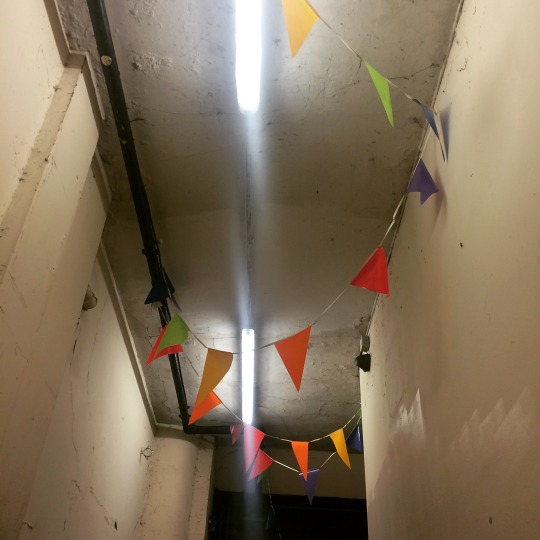
Facebook says:
“There is now far more content being made than there is time to absorb it. On average, there are 1,500 stories that could appear in a person’s News Feed each time they log onto Facebook. For people with lots of friends and Page likes, as many as 15,000 potential stories could appear any time they log on.”
Want your content chronologically served? Get ready to view a new piece every six seconds.
That night in Peckham showed me that we don't think about what we are recording.
But Blue Peckham Woman is no different from those recording a far away, barely visible stage at a gig with inaudible noise, or those sharing photos of their food or sharing every single place they visit via check ins on FourSquare.
The burden of data collection
GoPros mean we can record video without storage limitations on our phones. Smartphone storage and battery life are big issues to solve and will give us more time to record and room to store.
It made me wonder what will happen to all of our narrative recordings?
When my Nan died, we had a box of photos to cry and laugh over. It was a cathartic experience; I stored a couple of memory-provoking gems away on my dressing table.
Will my kids have that same experience?
No. They will have endless hard drives and a cloud with many thousands of files to trawl.
I can’t imagine that going through these will be fun or cathartic. I know it will be horrendous because it’s the very reason our images and movies aren’t neatly archived and labelled. There’s just too much to sort through already.
We’ve declared that life’s too short for ordering our narrative storage. Maybe life is too short to watch it through a lens as well?
0 notes
Text
The realities of using Jawbone UP24
Since September I've been on a huge health kick. I've taken up running, completely sorted my diet and lost 35lbs. I've used Instagram to help me and learned a lot about the gram fitness community along the way. But that's a story for another day.
To celebrate my success, I was given a Jawbone UP24 as a present. Yay! I've always wanted one and was so excited about using it.
It's been a rocky start, so I thought I'd share my experience from scratch...
Day 1 - Not syncing with MyFitnessPal
I click from Jawbone mobile app to connect with MyFitnessPal (MFP) from my iPhone. It asks for username/email. I add data. I then click from MFP mobile app to connect with Jawbone. It asks for my Jawbone account details which I add. After an hour, the MFP food still isn't syncing with Jawbone. I disconnect the apps from each other and repeat. Still not working. I then disconnect and repeat all this via desktop. Still not syncing.
This is common problem in the community.
While the UX of adding food into Jawbone via iPhone app is fine, the food library isn't as good as MFP. In particular, MFP has the option to create a recipe and gives you the nutrition data per portion. With Jawbone you can add ingredients as a group but not name them as a meal. This means if you have the same meal (say a Nutribullet shake every morning), you have to enter all the ingredients repeatedly (and there could be seven items each time). I have about 10 varieties of Nutribullet I eat, so that would be a welcome sync!
Day 2 - sleep data deleted and still not connected to MFP
Woke up to look at sleep data and compare to yesterday. Yesterday's sleep data had doubled to 13 hrs sleep (I wish). Odd. But a quick search shows me this is a common problem.
It showed two blocks of sleep for yesterday's data. I edited one of the blocks and removed it, as suggested by the community. It then wiped both blocks of data.
I then added it manually and lost all of the light/deep sleep patterns.
I read online that a soft reset can recover sleep data. I watched a video on how to do that, soft reset the band and looked for the sleep data. It's still showing the manual entry without patterns.
Jawbone tells me I can slide my home screen down to find a list of activities. There will be a question there asking if I was asleep. If I say yes, it will recover the sleep patterns.
I slide the home screen down. Nothing happens. There isn't another view. Maybe this is information for an old version?
MFP is still not syncing either. I read that making your MFP diary public will solve issue. I went into MFP via mobile app and made the diary public (which I don't really want to do, but I really want it to sync!) via mobile and reconnected to Jawbone. Unhelpfully this then takes you to desktop MFP (which isn't mobile responsive). But it does show Jawbone is connected. Jawbone also tells me MFP is connected. But nothing is syncing.
So far I have an expensive and pretty pedometer, as it can't sync food or track sleep. Ace. If I can't get the other two activities recording properly, I'll be returning it for a Fitbit.
CALL CENTRE RESPONSE
There is an iOS bug from the last Jawbone app update. It means that sleep is doubling for some iPhone users and there is also a problem with MFP sync. I've been told to uninstall the app, turn phone off/on and reinstall. We'll see if it works!
11 notes
·
View notes
Text
Problems, frustration and jealousy at UKGovcamp 2015
I headed to UKGovCamp 2015 - the unconference for those working in or with government - last month at Microsoft's Victoria offices.
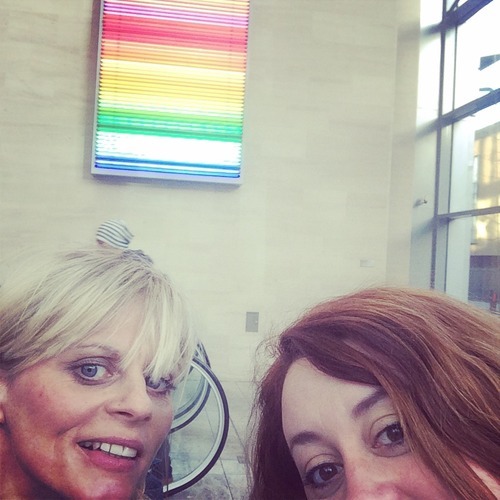
It's the second government unconference I've been to. In July, I headed to CommsCamp in Birmingham, organised by the marvellous Dan and Darren from Comms2Point0.
So what's moved forward in the last seven months? It seems pressure is still high, but three words popped out at me from the conversations: problems, frustration and jealousy.
There is a real danger that the trailblazing stuff the Government Digital Service (GDS) is doing makes everyone think that the same transformation is happening within local government.
There is a widening gap between central and local ability to transform services. But it's not just local government struggling to get some GDS action either, suppliers are also having difficulty sharing in the joy of delivering open source to government.
Read this warning post about trickle down blockage by Brighton UX agency Clearleft.
So here's a bit more on the three words that jumped out at me during #UKgc15.
Mo' problems
Lizzie and I held a session first thing to share some of the things around agile content creation to help those working in the public sector. We had a great turn out, which was great.
But before we could get to sharing, the round table wanted to share some of the problems they found in the day job. Well, I say 'some', once the flood gates were opened then the issues tumbled out after one another and consumed most of the session.
This prompted one attendee to lament, 'Always with the problems. What we need are the solutions.'
Unfortunately listening to the pain forms part of the solution finding. Mind you, the problems are sizeable...just read on.
The frustration and fear
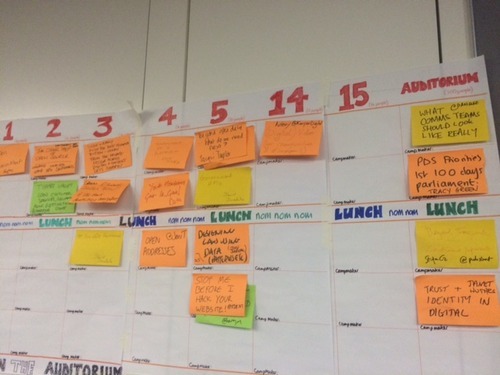
Some of the teams working in government have been on a rollercoaster of restructure since 2008. Have worked at the police, local government and the NHS, I have a fair idea of how exhausting restructure is.
People at UKGovcamp wanted time to think, space to apply what they are learning and sharing with each other and support.
Sadly restructure cycles mean there is an expectation to be 'busy'. They are scared that taking up thinking or learning time might make managers think they aren't 'busy' and could be disposable. So they are on a treadmill of 'busy' to prove they are needed. What a shame that there isn't enough time to share and work out how to really apply all the learning from unconferences.
There is a fear to experiment too, as experiments use taxpayer money. Mistakes cost cash, result in flack handling and it's hard to take it on the chin when there's a lack of support from management.
People are also frustrated at the lack of digital skills among SMT, the exodus of people to the private sector (and no returners), the pressure for 'more for less' and teams forgetting to involve the call centres, who are the closest to the users, in engagement projects.
The green eyes of jealousy
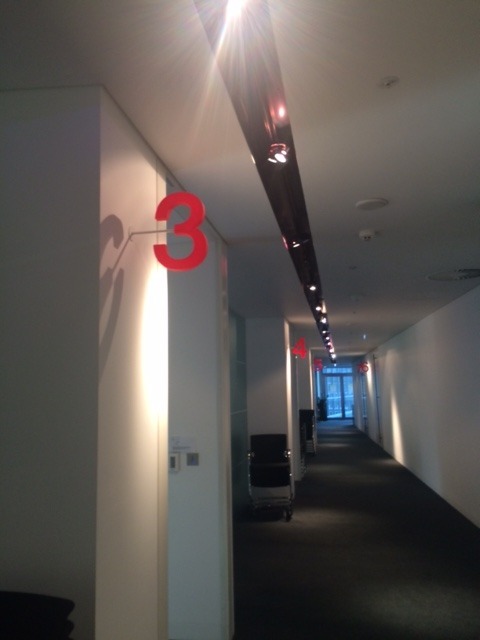
During the last year, every conference I've gone to has featured a speaker from GDS. Their agile approach - snakes of user needs, needotrons and constant user testing in a custom lab - is transforming government services.
But it's clear that local government is far from agile although there is a desperate desire to be more like GDS from the teams at UKGovcamp.
It's a fact that local government staff aren't sitting in multi-disciplinary teams, they are often far away from customer experience and they haven't got the chance to sprint, try, learn and twist with data.
It's still as sludgy, complex and bogged down in approvals processes that test even the most patient.
The GDS trickle down is much wanted, so what's in the way?
It's great listening to the very generous sharing about processes and findings from the GDS superstars, but it's a massive problem convincing the officers, cabinet members and leader of the council to understand it, sign it all off and embed.
What can the public sector learn from the private sector?
We talked pair writing - just head over here to the Google Doc where the notes are shared.
What can the private sector learn from the public sector?
UKGovcamp reminded me how much the private sector can learn from the public sector.
At a session called Failcamp with Alex Blandford, the anonymous shared the bleakest and most hilarious stories of bad website design, websites going down when the cleaner plugged in the hoover, comms horrors that would make your hair curl and accidental ordering fails.
While the offloading was amusing, the stories revealed serious heavy duty procedures. When taxpayer money is on the line, learning from fails is second nature in the public sector. Every error is poured over, digested, shared and learned from.
In a crisis, teams know their roles, perform them well and the machine runs smoothly. Process in the public sector when it comes to emergencies is something to behold.
So what next?
How about 'UKGovcamp - the solutions edition' or invite all the council leaders for trickle down training? Oh well, just a wish list, eh?! Until then local government are windowlicking outside GDS offices.
EDIT
Read the storify here of the comments following the post going live: https://storify.com/emilyaturner/localgov-digital-and-gds-innovation-chasm
0 notes
Text
Creating content the agile way
Last month I volunteered to help deliver Together London's Agile Content Conf at Sadler's Wells Theatre, London.
I'm a great believer in volunteering. I love the feeling of being part of a team that works together to deliver something fantastic for others. You form close bonds with people quickly, learn new skills and often find yourself in situations you wouldn't come across in your day job.
I worked with a brilliant group of people, including Angie, Kea, Steph, Jenn and Amy Marie. We supported Jonathan, Richard and Irit in making sure it ran smoothly.
I've put together some of the stand out moments from the event which I will take back to the work place.
1. Perfect is futile
Lisa Scott, Product Manager, GDS, made a point which resonated most with me, the quest for perfection. She said a drawn out process to perfect content or user experience was a waste of time. The approach she went through at GOV.UK was to publish early and respond quickly to feedback.
How many times have we sat in endless approval loops until something is deemed 'perfect'? Lisa's point is user needs might continue to evolve and content/online service needs to keep adjusting.
It's our job to educate stakeholders that content/websites aren't ever 'finished' or 'perfect' for the rest of time or a fixed three-year budget cycle.
Education is something Amy Wagner mentioned at the recent Agile Content MeetUp when she discussed facing down different character types. You know, the people who need content by a deadline for no reason other than to save face or working with someone who just "knows" the solution without any real evidence. Sometimes it's helpful just knowing that these "types" are to be found across all organisations.
2. Post-It notes aren't the best agile tool
3M must be praying at the Shrine of Agile, given the boost to Post-It sales. But Lisa Scott said that working out the 'snake of user needs' using Post-Its caused a number of problems, especially when they fell off the wall and got walked out of the room on someone's shoe.
This is why they built a tool to keep them together - the Needotron - which helped them assign formats to needs and prioritise them. You can see the open source code here.

I think we should all have a Needotron in our lives.
3. User needs aren't equal
Lisa reminded us that nearly all users come to your website for just a few things. You can't treat all the user needs equally, as it wouldn't make sense. Also, user needs can't always be met by just publishing content.
Another bit which got me nearly shouting approval out loud was when Lisa said processes do not solve problems, but multi-disciplinary teams do. Oh yes. I am converted on that completely. Processes don't make happy teams and, as Lisa pointed out, happy teams are productive teams.
4. Start reacting

Thum Yee Mun gave a wonderful talk about moving from agency world to a start up selling prescription eyewear.
She said the two worlds were very different, from client-led to user-led and from campaign-based to KPI-based.
She went though her experiences of agile content, "Our website said 'Shop our S/S 2014 collection'. Users asked us if we were Nazis. We couldn't understand how they didn't know it meant spring/summer."
One of the most valuable things in her presentation was when she told us to stop being thermometers, just measuring the temperature of the environment around ourselves, being static and collecting data.
She urged us to be thermostats and start reacting to the environment, being agile and using data.
5. Pair up for better content

Audun Rundberg said content wasn't where pedantry should sit above everything. Instead we should ask ourselves what questions we expect to be answered on the page and then ask where they are answered. This matters much more than typos.
Better web writing isn't printing off a website and getting excited with a red pen, editing and sending out unannounced. We need to think of ourselves as writing to meet a need (and not your boss' ideas of what is right or wrong) and feedback is vital.
Pair writing gives quick feedback and helps you question the content from the user perspective. It might slow down the initial draft but will be better focused and speed up the overall process. Collaboration means swift iterations and transparent conversations.
It would be interesting for me, as a generalist, to pair with a specialist. It would stop the edit rounds and help the specialist understand why getting the content right isn't just about factual accuracy. It would help them understand the value of user needs too.
6. Collaboration makes you better at your job

Jessica Wittebort, designer at MOJDigital, went back to the roots of agile. She said that no approach gives a seamless delivery and urged for teams to give empower people to pick their own tasks to increase motivation and productivity.
It made me gulp a little when Jessica said: "The more I do agile, the more I realise there is no perfect way to do it.
"Multi-disciplinary teams make you better at your job as you understand others' constraints."
I urge you to watch Jessica's talk...
7. Specialists don't rule the world
Chris Massey talked about coaching people to create better content. He went through his experience of getting the devs blogging, something I also have experience of.
He said the barriers were channels, motivations, skills and confidence, which I related to. He advocated active listening, where you wait for the other person to stop talking so you can say what you want to say. This helped him match up what he thought was blocking people from writing with how they really felt.
I will take this away and use. I think I would benefit from active listening and allowing people to express in their own time what their barriers are.
One of the things Chris said really hit home and that was the value of the specialist versus the generalist. He said generalists were really valuable to a multi-disciplinary team.
This was great to hear as generalists, in my experience, are often overlooked in favour of specialists. It makes sense that a generalist helps knit everyone together in a multi-disciplinary team.
When I got home, I mapped out my own hybrid skill set...

8. The agile content bootcamp
My favourite part of the day was facilitating a workshop with 10 attendees.
We were given a future world mega tech new product which we had to keep secret. We had to write as many user stories as we could for the product. Another group stepped over to our user stories and voted on the one they most identified with using stickers. They were not allowed to see the product details.
We selected the user story with the most votes, divided into pairs and started writing a title and first paragraph for landing page copy. We read them out and chose the best bits to form our collaborative draft.
Another group viewed our draft and stuck on it Post-Its detailing what they felt the mystery product offered in terms of benefits and their concerns.
We rewrote the copy taking this user feedback into account and shared with the rest of the audience with a big reveal of the product.

The exercise used everything we'd heard about in the day and agile processes. In our group of 10 we'd come up with landing page content which had considered user stories and received user feedback. All that in just one hour and a bit!
9. Support your audiences

I've been to quite a few events recently but the Agile Content Conf is the first event I've been to which has a behaviour policy to help speakers and the audience discuss ideas, problems and solutions within a safe environment free from intimidation and harassment.
The event works hard to help those who are attending on their own to meet like-minded others and network.
One of my roles was to help people collect a full set of trading cards which you can see above. The cards had an agile term on one side and an explanation example on the other side. Swapping cards with others started conversations and introduced people rather than leaving them occupying dark corners on their own.
The care taken to look after the audience really struck me. It can be very difficult for some to network or share their thoughts if they feel they will be made to feel unworthy.
More of this sort of thing across the event circuit ^^^
2 notes
·
View notes
Text
Agile Content MeetUp: Guerrilla User Testing
Here's a live blog from the Agile Content MeetUp tonight at the Book Club, Old Street. I'll correct the typos tomorrow!
Lily Dart, DXW

DXW is a small agency without a usertesting lab, they’re expensive and clients don’t have budgets to hire them.Guerrilla testing is a great way to introduce user testing into a project.
Content master, Martin Belam explains guerrilla testing as, “The art of pouncing on lone people in cafes and filming them while they use a website for a few minutes.” It’s taking a user testing lab into the general public.
How can we use this for content? It’s good for checking if your users can find content, if the language is right and if they’ve understood what they’ve read.
Considerations
Venue - where will you find target audience?
Time - have they got 10 mins and a space. You will need somewhere to sit down.
Internet access – Wifi, phone dongles and phone tethering don’t work well and are the quickest way to kill user testing
Devices – don’t assume doing the testing on a laptop is the easiest thing to do. Check which devices your audiences use
Record - can you record from your device? It will increase value of the session if you can record
Practice – Test explaining who you are, why you are there and what you want from them
Talking to the public
Offer to buy coffee and cake as a thank you
Ask permission to talk first. You are not a charity mugger
Say who you work for and explain what you want them to do
Some people will freak when you say you want to record the answers, so be prepared
Get signed permission for the recording
Scenarios
We use scenarios rather than tasks for user testing. A good scenario should be easy for users to relate to and plain English is key.
The scenario should describe a problem the user needs to solve. Don’t overload users with scenarios but give them the information they need to answer it. This doesn’t mean you should tell them what you want them to do. Their actions need to be natural to them so you need to be vague about what action you want them to take.
Running a session
Ask users to describe their thoughts as they go and speak out loud as they make decisions. Let users determine their success, don’t tell them when they’ve achieved it. So if they ask if they are on the right page, ask them if they think they are. After a scenario is complete, ask the user to what they would do next. Hopefully it will match with what you’d want them to do.
Amy Wagner, MOJDigital
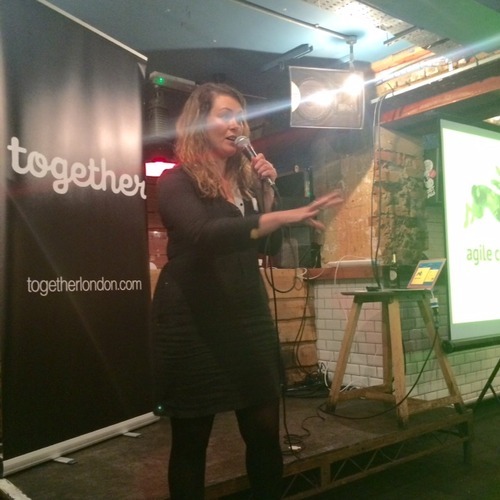
Consider the agile manifesto
Individuals and interactions
Working content
Customer collaboration
Responding to change
So why should content be agile? Because things don’t always go to plan and we can do things better than the plan.
Is your project about economies of scale? If it isn’t you don’t need to lock down your plan upfront and you can go agile. Is agile about being cheaper and faster? These are not the real reasons. We use agile to deliver the right thing. This then helps us deliver projects faster and cheaper.
Explore what your solution is. The project is more interesting when the solution is surprising. It is not easy to move a culture from assuming the answer to accepting it until we have the evidence.
It’s ok not to know what lies far ahead, but we will always know what lies immediately ahead. Keep focused on the right thing to deliver by seeking evidence.
Face down the difficult questions
If you’re trail blazing with agile, you’ll come across difficult people who ask questions because they are not at the same place in the agile journey as you.
Some will think they know what the solution is. You need to produce evidence using their way of working to get them to come around to your approach. Some fear change and you need to show that content can be changed cheaply.
You also need to help people understand that content isn’t finished by a deadline. Question deadlines and reasoning. Often it is to save face and it’s not about user needs. Take the deadlines and be led by user needs.
Top tips
1 Hypothesise – use this template, ‘We believe the users we’re trying to target will have this effect for this reason.'
2 Simplify – use themes to get a sense of the whole. Put into broad categories. Your user research will help. Plan just enough to get started.
3 Help everybody notice – use data to make the change you need to see
Interested?
Join the Meetup here.
0 notes